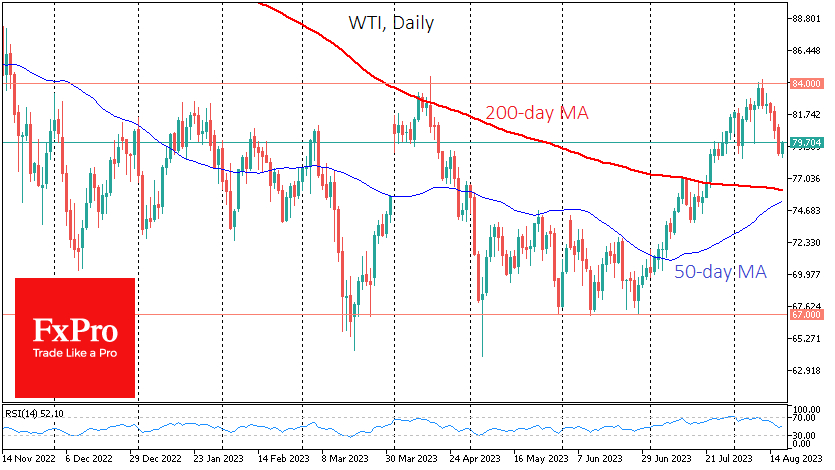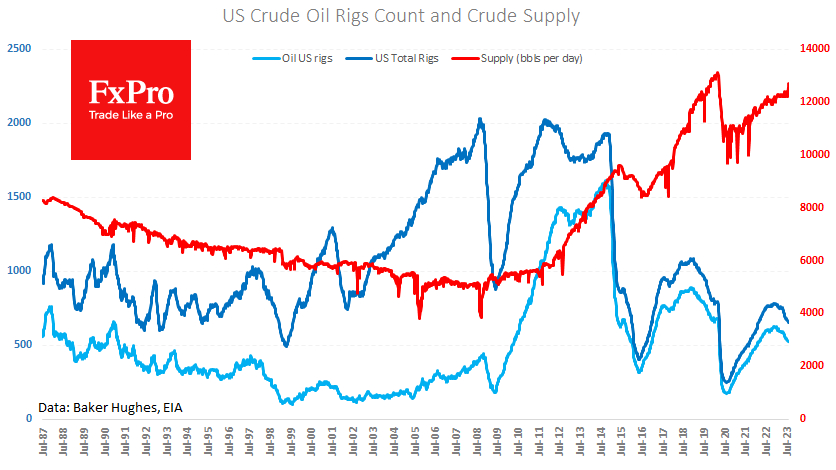WTI crude oil is down almost 7%, having fallen for the last seven days. The sell-off intensified as the price touched levels above $84. As has happened several times this year, this reversal could be a precursor to a fall to the lower end of the range around $67.
Risk appetite is waning in global markets as rising yields on US and European bonds make them more attractive from a risk/reward perspective.
China continues to publish disappointing growth reports, and problems in the country's construction sector are spreading through the economy. The Politburo's latest stimulus measures appear insufficient. As a result, markets are revising the demand outlook for the largest crude oil consumer.
At the same time, US producers are ramping up production. According to the weekly report released on Wednesday evening, average daily production climbed to 12.7M BPD last week - the highest since March 2020 - a notable breakthrough after several months of stagnation at 12.2M.
The jump in production looks like a reaction to the price rising to the top of the trading range since last November.
Demand has also played its part. Commercial stocks were up just 3% year-on-year, and the one-week drawdown at the end of July was the largest on record.
And this coincides with the start of cautious oil purchases into the Strategic Petroleum Reserve.
The latter two reasons look bullish for crude, but the speed at which the US has ramped up production over the past two weeks and increasingly worrying signs of slowing global demand outside the US, look more compelling for now.
From a technical perspective, WTI crude oil, having reversed from the upper boundary of the price corridor since November, is now moving towards its lower boundary at $67. So far, there is only one major obstacle: a potential crossover of the 50 and 200-day averages at $76.
The FxPro Analyst Team
- English (UK)
- English (India)
- English (Canada)
- English (Australia)
- English (South Africa)
- English (Philippines)
- English (Nigeria)
- Deutsch
- Español (España)
- Español (México)
- Français
- Italiano
- Nederlands
- Português (Portugal)
- Polski
- Português (Brasil)
- Русский
- Türkçe
- العربية
- Ελληνικά
- Svenska
- Suomi
- עברית
- 日本語
- 한국어
- 简体中文
- 繁體中文
- Bahasa Indonesia
- Bahasa Melayu
- ไทย
- Tiếng Việt
- हिंदी
Weak Global Economy and US Supply Growth Weigh on Oil Price
Published 08/17/2023, 07:11 AM
Updated 03/21/2024, 07:45 AM
Weak Global Economy and US Supply Growth Weigh on Oil Price
Latest comments
Loading next article…
Install Our App
Risk Disclosure: Trading in financial instruments and/or cryptocurrencies involves high risks including the risk of losing some, or all, of your investment amount, and may not be suitable for all investors. Prices of cryptocurrencies are extremely volatile and may be affected by external factors such as financial, regulatory or political events. Trading on margin increases the financial risks.
Before deciding to trade in financial instrument or cryptocurrencies you should be fully informed of the risks and costs associated with trading the financial markets, carefully consider your investment objectives, level of experience, and risk appetite, and seek professional advice where needed.
Fusion Media would like to remind you that the data contained in this website is not necessarily real-time nor accurate. The data and prices on the website are not necessarily provided by any market or exchange, but may be provided by market makers, and so prices may not be accurate and may differ from the actual price at any given market, meaning prices are indicative and not appropriate for trading purposes. Fusion Media and any provider of the data contained in this website will not accept liability for any loss or damage as a result of your trading, or your reliance on the information contained within this website.
It is prohibited to use, store, reproduce, display, modify, transmit or distribute the data contained in this website without the explicit prior written permission of Fusion Media and/or the data provider. All intellectual property rights are reserved by the providers and/or the exchange providing the data contained in this website.
Fusion Media may be compensated by the advertisers that appear on the website, based on your interaction with the advertisements or advertisers.
Before deciding to trade in financial instrument or cryptocurrencies you should be fully informed of the risks and costs associated with trading the financial markets, carefully consider your investment objectives, level of experience, and risk appetite, and seek professional advice where needed.
Fusion Media would like to remind you that the data contained in this website is not necessarily real-time nor accurate. The data and prices on the website are not necessarily provided by any market or exchange, but may be provided by market makers, and so prices may not be accurate and may differ from the actual price at any given market, meaning prices are indicative and not appropriate for trading purposes. Fusion Media and any provider of the data contained in this website will not accept liability for any loss or damage as a result of your trading, or your reliance on the information contained within this website.
It is prohibited to use, store, reproduce, display, modify, transmit or distribute the data contained in this website without the explicit prior written permission of Fusion Media and/or the data provider. All intellectual property rights are reserved by the providers and/or the exchange providing the data contained in this website.
Fusion Media may be compensated by the advertisers that appear on the website, based on your interaction with the advertisements or advertisers.
© 2007-2025 - Fusion Media Limited. All Rights Reserved.
